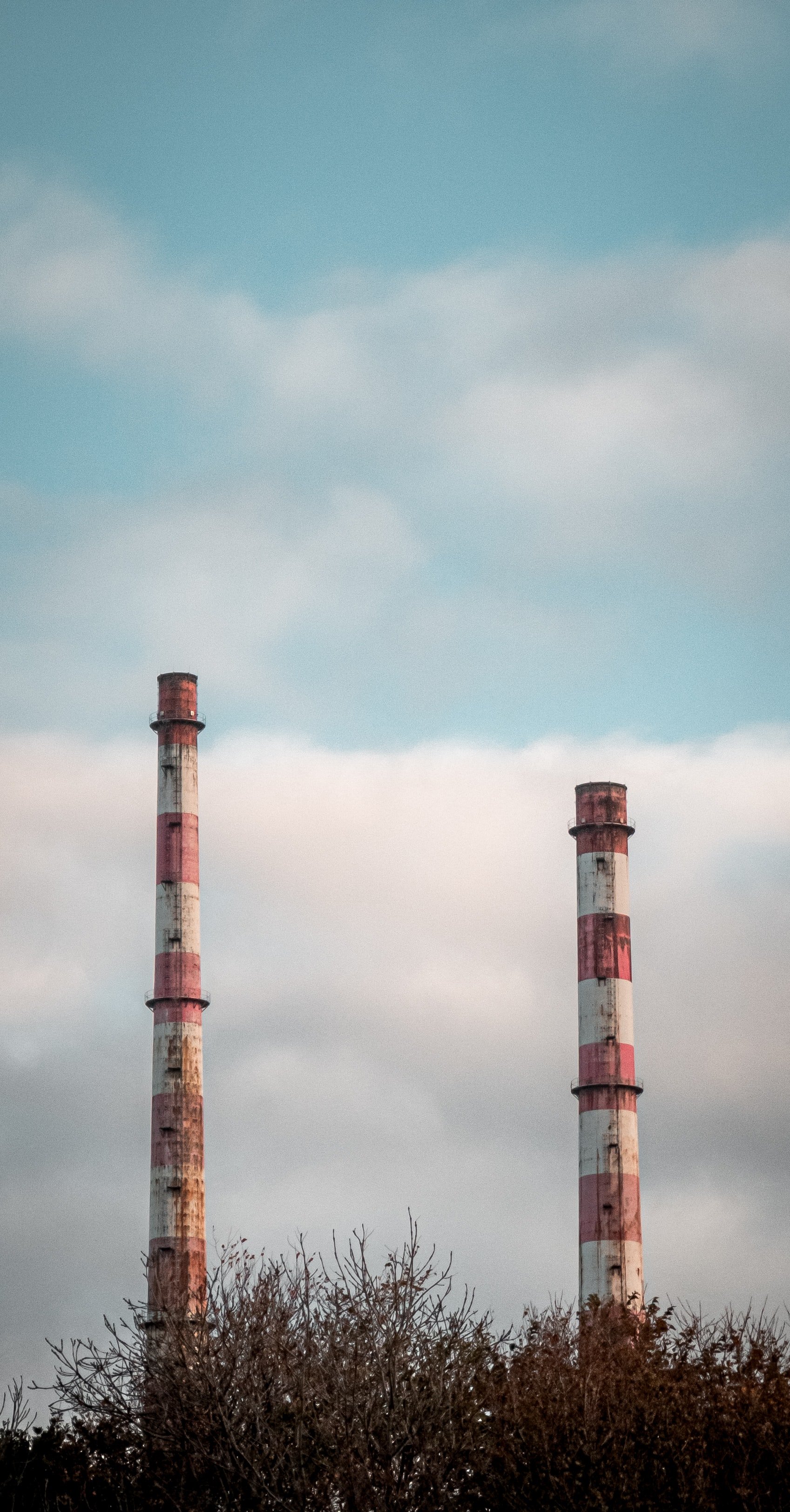A Tale Of Two Towns
The Two Chimneys at Poolbeg by Gabriel Ramos
5 minute read
Every weekday morning I drive in darkness through the north inner city – past Mountjoy, The Mater Hospital and North Circular Road, to come up through Fairview and onto the Clontarf Road, where I’m met with a spectacular sunrise over Dollymount Strand. The beauty is staggering and has caused me to burst out laughing sometimes. The sunlight splinters against the backdrop of the two chimneys and at times, a sea-liner. Occasionally, Brent geese are crossing the sky. I’m making this round trip from the Cabra Road to Clontarf so my kids can continue in the schools they’ve been attending since they were tots.
My family rented a home in Clontarf for eight years before seizing an opportunity to build a house on the Cabra Road. I had lived in the middle of this beauty but never felt its effect as dramatically as I do now. The strain of renting for longer than planned had taken its toll and the beauty of Clontarf was wasted on me.
Our build in Dublin 7 happened fairly quickly. The pandemic had created a blur of time for all of us and the build was swept up in that. I had no real sense of the neighbourhood I was moving into, I just considered that it was a mere 5km from where we had been living for the past eight years.
I’ve moved around quite a bit in my life, so I’m used to slight changes in the cultural tone of Dublin and bigger ones outside the pale, but I was floored at the difference 5km can make.
The first thing was the noise. Living on a thorough way for a prison and a hospital creates a lot of noise – ambulances, the siren wail of Gardai cars and speeding motorbikes. The homeless problem that is invisible in Dublin 3 is palpable in Dublin 7. I tried to feel positive about the changes the move had brought, but I was overwhelmed with nerves and could only feel and see aspects that put me on edge.
The first shift in my perspective happened quickly. Sitting in my new urban back garden one afternoon, I could hear orangutans calling to one another in the distance. It wasn’t long until I heard an elephant roar. These sounds were travelling from Dublin zoo straight into our back garden. It was city life at the front of our house, and jungle fever at the back. Now my son and I hoot back at the monkeys when they start their chatting within our earshot.
I began shopping locally, in the ‘seventeen shops’ lining the Cabra Road. This little group of stores has a village feel to them. Up until the corporation housing scheme in 1930, Cabra was a prominent market garden centre where cattle being brought to Hanlon’s Corner were kept in pens and grazing fields. Clarke’s bakery has been there for half a century and serves up delicious batch loaves, a refreshing change from the ubiquitous sourdough of the past ten years. Ethersons butcher is a delight; the several men and one woman butcher would charm the birds from the trees, but my favourite find is a tiny seafood shop called The Fresh Catch. It’s owned by a fisherman from Bantry, called Shane. The fresh hake, cod and lobster that’s available right in the middle of the seventeen shops is a glorious improbability. Not being charged through the nose to buy lemon sole is an added bonus.
The Victorian red brick and part-render, part-brick homes on the Cabra Road are beautiful. The mature trees that line the street add to this.
While they wouldn’t look out of place in Dublin 6, these homes have a bit more gumption; none of them are uniform in style; some incorporate Arts and Crafts-style windows and doors, others are more traditional. I spot a new favourite every time I stroll to the seventeen shops.
Trying to find a place to take a walk that would replace the wooden bridge and St Anne’s Park of my old routine took a little longer. I kept returning to The Phoenix Park sure that this would be the perfect place, but its enormity wasn’t for me on a regular basis. I’ve found my holy grail in the Grangegorman campus. The buildings, which were at different stages a workhouse, a prison and a hospital, had housed vulnerable people over the past 250 years. Strolling through here has really captured my imagination and a hopeful feeling of a maturing Ireland. I have no doubt that if I were born in a different era I would have been in danger of being locked up and considered an ‘hysterical’ woman for baseless reasons. I love seeing this history acknowledged and this space being used for health and education. What is also intoxicating is witnessing groups of young students in groups – laughing, kissing, fizzing with energy and sex. It’s life-affirming, especially after these last stale few years. These are groups that contain everyone – LGBTQ, people of colour, girls playing sport as predominantly as boys. It’s a proper joy to witness.
It’s ten months since we moved from Clontarf to Cabra and I no longer hear the road noise. Obviously, it is still here but I’ve become accustomed to it and barely notice. Moving into spring is going to change the timings and the colours of the sunrises I will get to enjoy on my commute across five kilometres in the coming months. Spring migrants from Africa will be due in the skies soon. I can’t wait.
Emer O’Connor Roche, March 2022
dear reader, tell us what you think in the comments below
join the conversation
share and comment below, we’d love to hear your thoughts…










